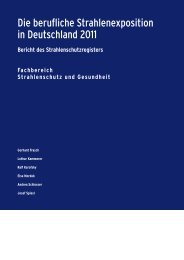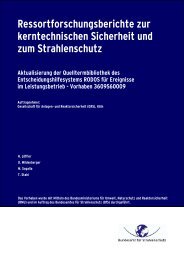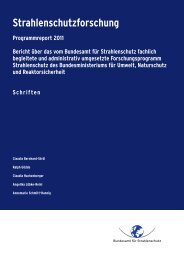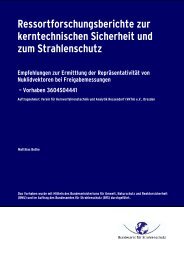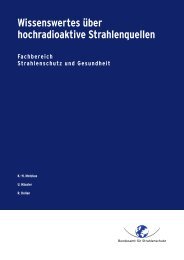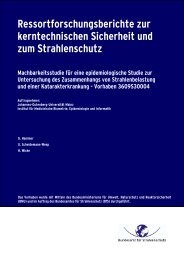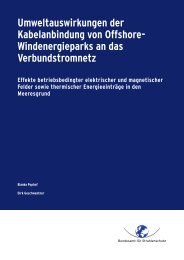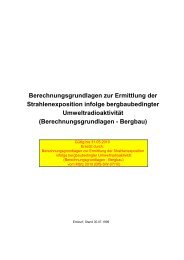Programmreport 2012 - DORIS - Bundesamt für Strahlenschutz
Programmreport 2012 - DORIS - Bundesamt für Strahlenschutz
Programmreport 2012 - DORIS - Bundesamt für Strahlenschutz
Sie wollen auch ein ePaper? Erhöhen Sie die Reichweite Ihrer Titel.
YUMPU macht aus Druck-PDFs automatisch weboptimierte ePaper, die Google liebt.
Summary<br />
On behalf of the Ministry for the Environment, Nature Conservation and Nuclear Safety (BMU) the Federal<br />
Office for Radiation Protection (BfS) awards research grants for projects in the field of radiation protection.<br />
The findings of these projects serve as decision aiding information in the development of radiation protection<br />
regulations as well as in the fulfilment of specific tasks in the field of radiation protection. Planning, technical<br />
and administrative preparation, awarding of contracts, general support as well as the technical evaluation of<br />
research and study projects are tasks of the Federal Office for Radiation Protection. This report provides information<br />
on preliminary (in the form of status reports) and, where applicable, final results of radiation protection<br />
projects within the BMU's Environmental Research Plan for the year <strong>2012</strong>.<br />
Preface<br />
Protecting man and the environment from the risk of ionising and non-ionising radiation is one of the most important<br />
responsibilities assigned to the Federal Ministry for the Environment, Nature Conservation and Nuclear<br />
Safety (BMU) and to the Federal Office for Radiation Protection (BfS). Implementation of these tasks and<br />
in particular the development of radiation protection guidelines and the supervision of the implementation of<br />
nuclear and radiation protection laws by the Federal States is only possible on a broad scientific-technical basis.<br />
Fundamental statements of the problem as well as questions related to the implementation of individual<br />
radiation protection measures have to be investigated and answered. To develop the necessary decision-aiding<br />
tools and for adequate implementation of the tasks, a broad thematic spectrum of investigative projects<br />
must be carried out (Departmental Research Programme).<br />
Introduction<br />
The subject areas of this report will be explained in detail in the following:<br />
One of the primary tasks consists in the assessment and evaluation of natural and artificial radiation exposures<br />
of man and the environment. For example, enrichment processes of natural radioactive substances<br />
(e. g. radon) or emerging trends in the artificial use of radioactive substances and ionising radiation must be<br />
identified and evaluated in a timely fashion so that appropriate measures can be taken to counteract any danger<br />
to man and the environment.<br />
A prerequisite not only for many of the studies but also for proving that dose level values have been kept is<br />
the availability of adequate measurement techniques and dose assessment procedures. The multifaceted and<br />
complicated measurement tasks needed in radiation protection technology require improving existing measurement<br />
techniques, developing new systems and continually checking and adjusting dosimetric models and<br />
data.<br />
The Radiation Protection Ordinance sets forth dose limits for acceptable radiation exposure of the general public,<br />
assuming that exposure below the limit will not give rise to any significant increase in natural radiation risk<br />
based on scientific findings hitherto existing. In the interest of achieving the most comprehensive radiation protection<br />
possible, it is necessary to continually update experience gained and adapt it to the latest standard of<br />
scientific and medical research. In order to attain more reliable evidence of radiation risk, in particular in the<br />
low dose range, the effects of ionising radiation to man must be further examined and evaluated. These<br />
effects can vary considerably depending on the individual. Therefore, procedures for identifying individual radio-sensitivity<br />
have to be developed.<br />
Today’s radiation protection philosophy is to a high degree determined by the principle of not adopting any<br />
action or practice leading to artificial exposure unless it produces sufficient benefit (so-called Principle of Justification)<br />
and keeping radiation exposure of justified activities and practices also as low as reasonably achievable<br />
(Principle of Optimisation). Both principles are stipulated in the Radiation Protection Ordinance. The observance<br />
of these principles will be controlled.<br />
Since man-made radiation exposure of the public is mainly made up of medical radiation exposure from diagnostic<br />
procedures, this latter is another focal point of the BMU Environmental Research Plan (Umweltforschungsplan)<br />
<strong>2012</strong>. It is crucial to balance the benefits and risks of diagnostic procedures, to search for alternative<br />
procedures involving lower risks, and to reduce radiation exposure by appropriate procedures.<br />
For protecting the population, it is important to investigate how radioactive substances behave in the environment,<br />
how they disperse in air and water, how they are enriched in the different ecosystems and their subsequent<br />
effect on man via the food chain. Thus, detailed information on radioecology is needed.<br />
XIX



